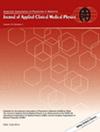Implementation of optically simulated luminescent dosimeter for quality control of gamma ray dose of an accelerator-based neutron source
Abstract
Background
Neutron beams utilized for performing BNCT are composed of a mixture of neutrons and gamma rays. Although much of the dose delivered to the cancer cells comes from the high LET particles produced by the boron neutron capture reaction, the dose delivered to the healthy tissues from unwanted gamma rays cannot be ignored. With the increase in the number of accelerators for BNCT, a detector system that is capable of measuring gamma ray dose in a mixed neutron/gamma irradiation field is crucial. Currently, BeO TLDs encased in quartz glass are used to measure gamma ray dose in a BNCT irradiation field. However, this type of TLD is no longer commercially available. A replacement dosimetry system is required to perform the recommended ongoing quality assurance of gamma ray measurement for a clinical BNCT system.
Purpose
The purpose of this study is to evaluate the characteristics of a BeO OSLD detector system under a mixed neutron and gamma ray irradiation field and to assess the suitability of the system for routine quality assurance measurements of an accelerator-based BNCT facility.
Methods
The myOSLD system by RadPro International GmbH was evaluated using the accelerator-based neutron source designed for clinical BNCT (NeuCure BNCT system). The readout constancy, linearity, dose rate effect, and fading effect of the OSLD were evaluated. Free-in-air and water phantom measurements were performed and compared with the TLD results and Monte Carlo simulation results. The PHITS Monte Carlo code was used for this study.
Results
The readout constancy was found to be stable over a month-long period and similar to the TLD results. The OSLD readout signal was found to be linear, with a high coefficient of determination (R2 ≥ 0.999) up to a proton charge of 3.6 C. There was no significant signal fading or dose rate dependency. The central axis depth dose and off-axis dose profile measurements agreed with both the TLD and Monte Carlo simulation results, within one standard deviation.
Conclusion
The myOSLD system was characterized using an accelerator system designed for clinical BNCT. The experimental measurements confirmed the OSLD achieved similar, if not superior to, the currently utilized dosimetry system for routine QA of an accelerator-based BNCT system. The OSLD system would be a suitable replacement for the current TLD system for performing routine QA of gamma ray dose measurement in a BNCT irradiation field.


 求助内容:
求助内容: 应助结果提醒方式:
应助结果提醒方式:


